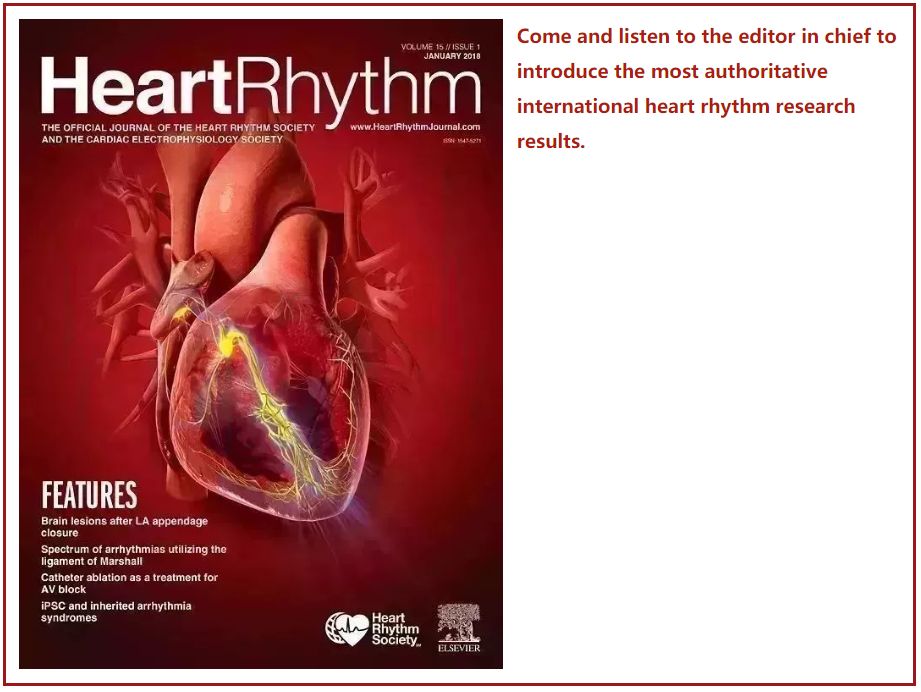Heart Rhythm主编—陈鹏生教授语音速递(十一月刊 英文版)
<< First issue in Nov 2018 >>

1
The featured article this month is titled “Stroke in patients with cardiovascular implantable electronic device infection undergoing transvenous lead removal” by Lee et al., from Mayo Clinic Arizona. An accompanying video author interview conducted by our online editor, Dr. Daniel Morin, can be found at the www.heartrhythmjournal.com website. The authors performed a retrospective analysis of all patients undergoing transvenous lead removal for CIED infection from all 3 tertiary referral centers of the Mayo Clinic. A total of 774 patients were analyzed. The stroke rate in this cohort was 1.9%. A patent foramen ovale was identified in 46.7% of patients with stroke compared to only 12.9% of patients without stroke. The authors conclude that in patients with CIED infection undergoing transvenous lead removal, the presence of PFO, especially with a right-sided vegetation and right to-left shunting, was associated with an increased risk of stroke. This finding suggests that PFO screening before transvenous lead removal warrants meticulous attention. Because stroke can be a devastating complication in patients with CIED infection, these findings are clinically important. However, this study is limited by the retrospective study design. It is also unclear if pre-procedural screening for PFO, and any potential intervention that could be performed, can reduce the rate of stroke.
2
The next article is titled “Intermittent anticoagulation guided by continuous atrial fibrillation burden monitoring using dual-chamber pacemakers and implantable cardioverter-defibrillators” by Waks et al.from Beth Israel Deaconess Medical Center, Boston, Massachusetts. The authors hypothesize that continuous rhythm assessment with pacemakers or ICDs and use of direct-acting oral anticoagulants (DOACs) may allow anticoagulation only around the time of AF episodes, reducing bleeding without increasing thromboembolic risk compared with constant DOAC use. They studied 48 patients monitored for a total of 14,826 days. Patients used DOACs for 3,763 days, representing a 75% reduction in anticoagulation time compared to chronic administration. There were no thromboembolic events. The authors conclude that among patients with rare AF episodes and low-to-moderate stroke risk, pacemaker- or ICD-guided DOAC administration is feasible and decreased anticoagulation utilization by 75%. This pilot study suggests that device-guided DOAC administration may prove to be a viable alternative to chronic anticoagulation. A larger clinical trial will be needed to confirm these conclusions.
3
Next up is a paper titled “Seasonal variation in the risk of ischemic stroke in patients with atrial fibrillation” by Liao et al from Taipei Veterans General Hospital, Taipei, Taiwan. This study used the National Health Insurance Research Database in Taiwan. From 2000 to 2012, a total of 289,000 AF patients were enrolled, and 35,000 experienced ischemic stroke after mean follow-up of 3 years. The authors found that the highest incidence of ischemic stroke was observed in winter. Compared with the summer period, the risk of ischemic stroke increased by 10% in spring and by 19% in winter. Lower average temperatures were significantly associated with an increased risk of ischemic stroke. The authors conclude that a seasonal variation of incidence of ischemic stroke in AF patients was observed, with an increased risk of stroke on days with an average temperature <20°C. This paper raises an interesting question of whether there is an association between temperature and stroke. However, a study using an administrative database has many limitations. The mechanisms by which stroke may be associated with cold temperature remain unknown.
4
Misra et al. from Johns Hopkins University School of Medicine write the following article titled “Field of view of mapping catheters quantified by electrogram associations with radius of myocardial attenuation on contrast-enhanced cardiac computed tomography”. The authors studied 15 patients with post-infarct VT who underwent catheter ablation with pre-procedural contrast-enhanced cardiac CT. Electroanatomic maps were registered to contrast-enhanced cardiac CT and myocardial attenuation surrounding each endocardial point was measured at radii of 5, 10, and 15 mm. The authors found a significant association between bipolar and unipolar voltage with myocardial attenuation at all radii. For unipolar voltage, the best model fit was at an analysis radius of 15 mm regardless of mapping catheter used. For bipolar voltage, the best model fit was at an analysis radius of 15 mm for points acquired with a conventional ablation catheter. In contrast, the best model fit for points acquired with a multipolar mapping catheter was at an analysis radius of 5 mm. Smaller electrodes may provide improved spatial resolution for definition of myocardial substrate for VT ablation. These findings are important because they will allow operators to focus on identifying regions of the myocardium susceptible for VT ablations. A limitation is that the authors do not yet have outcomes data to confirm the clinical importance of these findings on VT ablation.
5
The next paper is titled “Safety and efficacy of catheter ablation of ventricular arrhythmias with para-Hisian origin via a systematic direct approach from the aortic sinus cusp”, written by Wei et al.from Fuwai Hospital, Beijing, China. The authors studied 21 consecutive patients with ventricular arrhythmias of para-Hisian origin. Ablation was preferentially performed within the aortic sinus cusps in all patients. The results show successful ablation in 17 of 21, or 81%, of the cases. In the remaining 4 patients, RF application was performed in the target site of the RV septum around the His bundle region, and the clinical ventricular arrhythmias were eliminated in 2 of 4 of those patients. During a mean follow-up of 3 years, 1 patient out of the 19 acutely successful cases had recurrent arrhythmia. The authors conclude that catheter ablation of ventricular arrhythmias originating from the para-Hisian area via a direct approach from the aortic sinus cusps may be safe and effective in most unselected patients. This paper reminds me of a paper by Zhang et al.from Wuhan, China, published in the January 2018 issue of Heart Rhythm. In that paper, the authors reported that mapping and ablation of pulmonary sinus cusps eliminated 90% of unselected idiopathic RVOT-type ventricular arrhythmias with favorable mid-term effectiveness. While it is known for years that ventricular arrhythmias can originate from aortic sinus cusps and pulmonary sinus cusps, they were thought to be unusual. When mapping and ablation in the ventricles fail to eliminate arrhythmias, then mapping in the cusps may be considered. These two papers argue for the opposite approach, that is, ablation in the cusps first before ablation in the ventricular sites. It is unclear if these findings are particular to Chinese patients, or are generally applicable to these ventricular arrhythmias everywhere in the world. I am sure more people will soon report their experiences with these approaches.
6
Next up is a paper titled “Electrophysiological features and radiofrequency catheter ablation of supraventricular tachycardia in patients with persistent left superior vena cava” written by Uhm et al from Yonsei University College of Medicine, Seoul, Korea. The authors studied 37 patients with and 510 patients without persistent left superior vena cava who underwent an electrophysiology study for SVT. In patients with persistent left SVC, 40 tachycardias were induced. They included AVNRT, AVRT, and focal AT. Among patients with AVNRT, 47% of those with persistent left SVC had a slow pathway in the coronary sinus, as compared with only 4% in patients without persistent left SVC. In patients with a left accessory pathway, the number of RF catheter ablation attempts and recurrence were lower in the great cardiac vein group than in the left superior vena cava group. The authors conclude that a slow pathway within the coronary sinus is common in patients with AVNRT and persistent left SVC. It is useful to place a CS catheter into the great cardiac vein in patients with a left accessory pathway and persistent left SVC. In most people, the embryonic left superior vena cava becomes the vein of Marshall. Both the vein of Marshall and persistent left SVC are known to be sources of atrial fibrillation and may serve as conduits for accessory pathway conduction. This current manuscript extends the observation to slow AV nodal pathways.
7
The next article is “Protamine to expedite vascular hemostasis after catheter ablation of atrial fibrillation: a randomized controlled trial” by Ghannam et al., from the University of Michigan. They studied 150 patients who underwent catheter ablation for atrial fibrillation or left atrial flutter. They were randomized to receive postprocedure protamine or to the control group. The results show that the maximum ACT during catheter ablation averaged 359 in both groups. However, time to hemostasis was 123 min in the protamine group, which was significantly shorter than the 260 min in the control group. Time to ambulation was also significantly shorter in protamine than control group. There were no differences in the rates of major or minor vascular access complications or thromboembolic events. The authors conclude that protamine expedites vascular hemostasis and time to ambulation by about 3 hours without an increase in the risk of vascular or thromboembolic complications. A limitation of this study is that it was not powered to detect significant reductions in major vascular or thromboembolic complications. However, reduction of the time to ambulation alone may be beneficial to patients undergoing ablation.
8
Next up is a manuscript written by Söth-Hansen et al. from Aarhus University Hospital, Denmark. The title is “Time until diagnosis of clinical events with different remote monitoring systems in Implantable Cardioverter-Defibrillator patients”. The authors studied 1802 consecutive patients followed with remote monitoring from 2014 to 2016. Devices made by Biotronik, Boston Scientific, Medtronic, and St. Jude were represented in the study. There were 3,472 events. Proportion of events acknowledged within 24 hours ranged from 18% to 72% among the 4 different manufacturers, with median times from detection to acknowledgement ranging from 13 to 222 hours. Variation in time to acknowledgement of ventricular tachyarrhythmia episodes not treated with shock therapy was the primary cause for the difference between manufacturers. The authors state that early detection of those non-treated episodes are clinically important. However, this study is limited by the retrospective study design. Whether or not delay in reporting non-treated ventricular arrhythmic events negatively affected the patient outcomes in this patient cohort remains unclear.
9
Next up is “Simultaneous Traction from Above and Below during Lead Extraction” by Schaller et al. from Hospital of the University of Pennsylvania. The authors studied 15 patients referred for transvenous lead extraction of an ICD lead. Average lead dwell time was 8 years. Simultaneous traction showed greater leftward fluoroscopic shift compared to traction from above, created greater separation between the lead and SVC wall upon intracardiac echo imaging, and maintained a more parallel relationship of the lead with the SVC wall. The authors conclude that in patients presenting for transvenous lead extraction, simultaneous traction results in increased separation and a more parallel alignment of the lead and SVC wall, allowing the sheath to be better oriented into the desired cleavage plane. This improved sheath alignment is particularly critical when powered sheaths are to be used. The authors included detailed illustrations in the manuscript to provide practical guidance in performing simultaneous traction
10
Adelstein et al. from University of Pittsburgh wrote the next article, titled “Scar Burden, Not Intraventricular Conduction Delay Pattern, Is Associated with Outcomes in Ischemic Cardiomyopathy Patients Receiving Cardiac Resynchronization Therapy”. The authors analyzed 393 consecutive ischemic cardiomyopathy patients with LVEF ≤35%, QRS duration >120 ms, and LBBB or non-specific IVCD who underwent single-photon emission computed tomography myocardial perfusion imaging and CRT-defibrillator implant. They found that nonspecific IVCD is associated with greater scar burden and narrower baseline QRS duration than LBBB. LVEF improved less in patients with IVCD versus LBBB, but only scar burden, and not QRS morphology or duration, was associated with LVEF increase ≥5%. During 39 months of follow-up, IVCD was associated with shorter survival free from transplant/ or VAD and shorter time to first appropriate device shock. Scar burden, but not QRS morphology, was independently associated with these outcomes on multivariable analysis. The authors conclude that IVCD is associated with greater scar burden than LBBB in ischemic cardiomyopathy CRT-defibrillator recipients. Scar burden, not QRS pattern, is independently associated with adverse clinical outcomes. This study further supports the need to look beyond LBBB as the main criterion for CRT implantation. In addition, it provides an important addition to the literature by integrating imaging measures with detailed clinical characteristics.
11
Next up is an article titled “Adherence to 2016 European society of cardiology guidelines predicts outcome in a large real-world population of heart failure patients requiring cardiac resynchronization therapy”. The paper was written by Stabile et al, Clinica Mediterranea, Napoli, Italy. The authors collected data on 930 consecutive patients from the CRT-MORE registry. The primary endpoint was a composite of death and heart failure hospitalization. They included 563 patients who met Class I indications, 145 who met Class IIa, 108 who met Class IIb and 114 who met Class III indications. After a median follow-up of 1000 days, they found that the time to the end-point was longer among patients with a Class I indication. Adherence to Class I was associated with an absolute LV ejection fraction increase of >5 points and an LV end systolic volume decrease of ≥15%. The authors conclude that about 60% of patients underwent implantation according to a 2016 European HF guidelines Class I indication, and that adherence to Class I indications was associated with a lower death and heart failure hospitalization rate and superior LV reverse remodeling. These findings reaffirm the importance of guideline compliance in CRT therapy
12
The next paper is titled “Reduced left ventricular mechanical dispersion in heart failure patients undergoing cardiac resynchronisation therapy is associated with superior long-term outcome” written by van der Bijl et al. from Leiden University Medical Center, the Netherlands. Clinical, echocardiographic and ventricular arrhythmia data were analyzed from an ongoing registry of heart failure recipients of CRT. They included 1,185 patients. Among them, 29% died during a mean follow-up of 55 months. Patients with left ventricular mechanical dispersion of <84 ms at 6 months post-CRT had lower event rates compared to those with LVMD >84 ms. On multivariable analysis, greater left ventricular mechanical dispersion at 6 months after CRT was independently associated with an increased risk of mortality. The authors conclude that larger left ventricular mechanical dispersion at 6 months after CRT is independently associated with all-cause mortality and ventricular arrhythmias. Therefore, echocardiographic left ventricular mechanical dispersion may be valuable in identifying patients who remain at high mortality risk after CRT implantation. A limitation is that these data were obtained 6 months after implant. No data are available from those who died earlier than 6 months.
13
Mar et al. from the University of Louisville, Kentucky wrote the following article titled “Cost-effectiveness analysis of magnetic resonance imaging–conditional pacemaker implantation: Insights from a multicenter study and implications in the current era”. The incremental cost-effectiveness ratio (ICER) was calculated as the sum of the total incremental cost of implanting a MRI conditional pacemaker vs. a conventional pacemaker and the cost of MRI scans, divided by the utility of MRI scans in terms of quality-adjusted life-years gained. The projected percentage of patients receiving MRI scans at 11 years was 58%, yielding an ICER of $74,221 per quality-adjusted life-year. The authors conclude that MRI conditional pacemaker implantation is cost-effective over the lifespan of the pacemaker based on projected usage of MRI. The most common benchmark for cost-effectiveness is renal dialysis, which is currently estimated to cost $100,000 per quality-adjusted life-years in the United States. This benchmark may not be applicable to countries that do not have government funded dialysis programs.
14
Next up is “The electrophysiological effects of nicotinic and electrical stimulation of intrinsic cardiac ganglia in the absence of extrinsic autonomic nerves in the rabbit heart” by Allen et al. from University of Leicester, United Kingdom. The authors applied nicotinic or electrical stimulation at discrete sites of the intrinsic cardiac nerve plexus in the Langendorff perfused rabbit heart. Stimulation within all ganglia produced either bradycardia, tachycardia or a biphasic brady-tachycardia. Neurons immunoreactive only for cholinacetyltransferase, or tyrosine hydroxylase or nNOS were consistently located within the limits of the hilum and at the roots of the right cranial and right pulmonary veins. Among them, cholinacetyltransferase immunoresponsive neurons were most abundant. The authors conclude that stimulation of intrinsic ganglia, shown to be of phenotypic complexity but predominantly of cholinergic nature, indicates that clusters of neurons are capable of independent selective effects on cardiac electrophysiology, therefore providing a potential therapeutic target for the prevention and treatment of cardiac disease. A new finding of the study is the characterization of the distribution of nNOS, or neuronal nitric oxide synthase, neurons. nNOS is the enzyme responsible for the synthesis of nitric oxide, which is an important signaling molecule. Exploration of the physiology of these nNOS neurons will need further study.
15
The next article is titled “The application of kinomic array analysis to screen for altered kinases in atrial fibrillation remodeling” by Meijering et al., from University of Groningen, the Netherlands. The authors employ kinomic profiling to identify kinases altered in AF remodeling using atrial tissue from a canine tachypacing AF model. They found that pacing to tachycardia induced changes in activity of 50 kinases. Among them, 40 of these changes were prevented by geranylgeranylacetone treatment, which protects the atria against tachypacing-induced atrial remodeling. The authors conclude that contrasting kinomic array analyses of control and treated subjects offers a versatile tool to identify kinases altered in atrial remodeling due to tachypacing. Ultimately, pharmacological targeting of altered kinases may offer novel therapeutic possibilities to treat clinical AF. Kinomic profiling refers to the determination of global kinase activity in a specimen and is distinct from genomic and proteomic methods because it determines changes in biological activity, not just the presence of a gene, transcript, or protein. Broader adaptation of these methods in research may help us better understand the mechanisms of AF and its treatment.
16
Next up is “Association of fibrotic remodeling and cytokines/chemokines content in epicardial adipose tissue with atrial myocardial fibrosis in patients with atrial fibrillation” by Abe et al from Oita University, Japan. The authors obtained left atrial appendage samples from 59 consecutive AF patients during cardiovascular surgery. Histology revealed that the severity of fibrotic remodeling of epicardial adipose tissue was associated with LA myocardial fibrosis. Immunohistochemical and electron microscopic findings revealed that fibrotic remodeling of epicardial adipose tissue was associated with infiltration of macrophages and myofibroblasts. The total collagen in the LA myocardium was positively correlated with proinflammatory and profibrotic cytokines and chemokines. This study demonstrated that fibrotic remodeling, cytokines and chemokines in peri-left atrial epicardial adipose tissue were associated with atrial myocardial fibrosis as a substrate of AF. Hypoxia-inducible factor-1α and angiopoietin-like protein-2 may be involved in this process. These results provide new insights into the association between epicardial adipose tissue and atrial fibrillation. The study is limited by the sample size and the absence of specimens from normal healthy people for analyses.
17
Richards et al. from ProMedica Cardiology, in Toledo, Ohio wrote the following article titled “The Addition of Minute Ventilation to Rate Responsive Pacing Improves Heart Rate Score More than Accelerometer Alone”. The heart rate score is the percent of all beats in the predominant 10 bpm bin. Heart rate score ≥ 70% predicts risk of mortality in patients with ICDs and identifies patients who have survival benefit with DDDR versus DDD pacing. The authors analyzed data from the LIFE study, which is a prospective, randomized pacemaker study comparing accelerometer to dual sensor rate-responsive pacing. The dual sensor includes both accelerometer and minute ventilation sensors. Among 501 randomized patients, heart rate score ≥70% during DDD pacing occurred in 43% of patients at baseline. In these, heart rate score decreased by 14% after DDDR programming. No differences were detected between the two randomized sensor-based groups at baseline. Dual-sensor programming reduced heart rate score substantially more than accelerometer sensor alone. The authors conclude that heart rate score improved with DDDR programming in pacemaker patients with high heart rate score during DDD pacing. Dual sensors improved heart rate score more than accelerometer alone. While promising, this programming approach needs to be investigated prospectively in a pacemaker outcomes trial.
In addition to the original articles I’ve discussed, this issue of the journal also publishes an Unknown of the Month article on “Wide and narrow QRS complex tachycardia with four different cycle lengths”, a Josephson and Wellens ECG titled “Peculiar ECG after an intracardiac intervention in a 41 year old woman”, 4 EP News articles, and two letters to editors.
I hope you enjoyed this podcast. For Heart Rhythm, I’m Editor-In-Chief, Dr. Peng-Sheng Chen.











